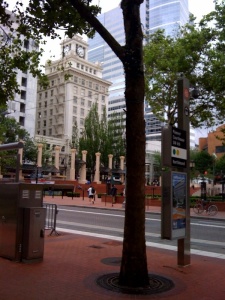Among those engaged in the sustainable downtown movement, the chatter these days is about a Pacific Northwest city known more for its rainy days than its livability. I am of course referring to Portland, Oregon. And all of the acclaim it has been receiving for its model practices is for good reason.
I recently traveled again to Portland, a short one-hour flight from my home in Sacramento. Cheap round trip airfare and inexpensive lodging at a hotel in the heart of downtown made for a quick and ideal jaunt. Oregon merits another gold star for cost-conscious budgets like mine — it has no sales tax, which meant my wallet was barely impacted from this brief excursion.
So what makes downtown Portland such a desirable locale? For starters, walkability and safety — key elements to generating foot traffic in any central-city area. There is also an enormous amount of civic pride pulsating throughout the area. Everyone I talked to, from bartenders to law enforcement officers, to local university students and seniors, had nothing but good things to say about the quality of life in Portland.
The annual Rose Festival, held the weekend I was there, offered an up-close glimpse of this pride in action. Thousands of locals and out-of-towners lined the streets of downtown for what is widely considered to be the second largest parade in the nation, eclipsed only by Pasadena’s Rose Parade. During the five-hour festivities the downtown core hummed with floats, bands, food vendors and wide-eyed children taking it all in with their parents.
Perhaps most impressive was the ease with which people arrived at and departed from the parade route without the use of cars, thanks in large part to the city’s ultra-efficient light rail train system. Known as the Max, it is long reputed to be the benchmark for urban transportation in the U.S.
One of the defining symbols of Portland’s downtown culture is the infamous Powell’s Books, an independent bookseller that has been in existence since 1971. Housed in buildings that span several city blocks, Powell’s is a boon for readers who possess a voracious appetite for a wide range of used and new books.
A few blocks from Powell’s is the trendy Pearl District, an area that has been redeveloped into a popular enclave for young area professionals. At night this area attracts an urbane, hip crowd that frequents the many of the local dining and entertainment venues in the area. One of my favorite dining establishments in the area, The Blossoming Lotus Cafe, is located adjacent to a yoga studio. One dish I ordered — a vegan stir fry — was so tasty that I had to muster Herculean strength not to to lick the bowl. Walk just a few short blocks and you will discover Jimmy Maks, a jazz club with a stellar reputation. On the evening I visited, Hailey Niswanger, a young, emerging superstar saxophonist, gave a performance that illustrated why Portland has a long history of producing top-name artists and entertainers.
Of course, Portland is by no means a perfect city. Issues of homelessness are quite evident as you walk the city streets. And the economic downturn appears to be rearing its ugly head in the form of high unemployment and a growing number of boarded up buildings throughout the central-city area. A downtown bartender summed up the response of city inhabitants this way, “Portlanders tend to let things slide off their back. In fact, if a person here has only $10.00 left in their pocket for the month, they are probably going to spend it on food and drinks, which keeps our economy moving.”
In the end, few would dispute the vibrancy of Portland and its downtown. It possesses a well-thought-out infrastructure and a culture that is visionary and forward-thinking — necessary catalysts for downtown central-city sustainability.

